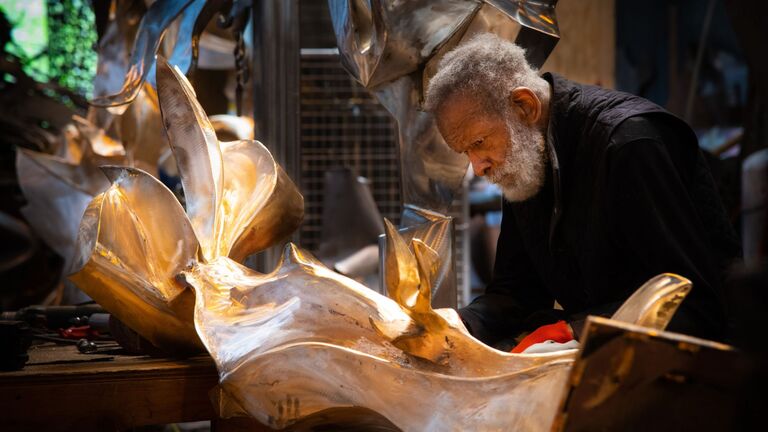
Richard Hunt in his Chicago studio finishing a large-scale sculpture for The Riverfront Revitalization Project and the Gene Leahy Mall Park in downtown Omaha, Nebraska. Photo by Jim Grot
SAIC Mourns the Passing of Richard Hunt
December 18, 2023
Dear SAIC Community,
On view at the Art Institute of Chicago, greeting visitors from its perch on the Women’s Board Grand Staircase, is a figure both noble and humble. Assembled from salvaged and new metal, this found-object assemblage suggests a classical champion in its poise and solidity. Yet it is welded together with a lively intuition, revealing its modernity. It is a lynchpin of the museum’s encyclopedic collection, promising that on our School/museum campus we find both eons of human thought and how artists craft that inspiration to construct humanity’s future. The artwork, Hero Construction, is made by one of SAIC’s most heroic creators, Richard Hunt (BAE 1957, HON 1979), who sadly died on December 16 at the age of 88.
Born and raised in Chicago, Richard has a long and deep association with SAIC and the museum. He began taking youth classes here at the age of 13, and Hero Construction (1958) was made, and then collected by the museum, within a year of Richard completing his bachelor’s degree at the School. As he described in an interview on the museum’s website, it was during his undergraduate study that he became enamored with the metal sculptures of Pablo Picasso and Julio González, which he saw at the museum, and began experimenting with soldering forms before augmenting his skill with metal design classes, as the School’s sculpture classes focused on clay and wood at that time. This spirit of multimedia invention, which characterizes so many SAIC artists, led to the direct welding technique for which Richard became well-known. Whether assembling castoff scraps or shaping raw metal, Richard’s largely abstract work has an emergent, impromptu quality with a freedom of form that suggests flight, uplift, and emancipation.
But, like any good jazz musician, Richard’s improvisation was enabled by a deep capacity for planning and research that allowed him to work on a monumental scale. A sound draftsperson and a voracious bookworm, Richard reviewed multiple newspapers each day; kept an extensive library, with depth in Western and African art and African American history; and took great inspiration from music, mostly classical as well as jazz. This interdisciplinary foundation led to Richard’s notability as a public artist, with more than 150 works on view in public spaces, many right here in Chicago, including works at the Carter G. Woodson Library (Jacob's Ladder, 1977), Chicago State University (Building and Growing, 2012), Dr. Martin Luther King, Jr. Community Service Center (From Here to There, 1975), Jonquil Park (Eagle Columns, 1989), Midway International Airport (Flight Forms, 2002), Soldier Field (Eternal Flame of Hope, 2018), and State of Illinois Building (Freeform, 1993) among others. Nearby campus, you can see his totemic and inclusive take on one of the city’s mottos, We Will (2005), just north of the Chicago Cultural Center.
Many of Richard’s works address moments of struggle, achievement, and inspiration in Black American life. His architecturally scaled The Light of Truth Ida B. Wells National Monument (2021) in Chicago’s Bronzeville neighborhood commemorates the famed journalist and civil rights activist, and his divinely suspended artwork, Swing Low (2016), bracingly draws visitors into the lobby of the Smithsonian’s National Museum of African American History and Culture in Washington, DC. Richard also participated in civil rights actions, receiving a proclamation for participating in the peaceful integration of a Woolworth’s lunch counter in San Antonio, Texas, in 1960, attended the funerals of both Emmett Till and Mamie Till-Mobley, and saw his artwork as part a collective action, saying, “Sculpture is not a self-declaration but a voice of and for my people—over all, a rich fabric; under all, the dynamism of the African American people."
For his phenomenal contribution, Richard was highly decorated in his lifetime. He was the first African American sculptor to have a retrospective at the Museum of Modern Art in New York, and he is the recipient of numerous awards, including prizes from the International Sculpture Center, Chicago Department of Cultural Affairs, DuSable Black History Museum and Education Center, Studio Museum in Harlem, and the Art Institute of Chicago. June 9, 2022, was declared Richard Hunt Day in Chicago, and April 24, 2023, was declared Richard Hunt Day in Illinois. Richard also received 17 honorary degrees, including one from SAIC in 1979. Upon commissioning a new work for the Obama Presidential Center, former President Barack Obama called Richard, “One of the greatest artists Chicago ever produced.”
Beyond his incomparable work and impressive accomplishments, Richard Hunt will be remembered as a generous mentor, incessant maker, humble talent, and inspirational man. Though he has left us, his work and his spirit endure, urging artists, designers, and scholars to take flight—making new work and a brighter future. In a career-spanning monograph, published in 2022, Richard reminds us that, “Artists have a unique opportunity to make a difference…to look and work toward the future. We have the job of creating new ideas and visions for the future, and I’m pleased to be a part of that.”
Elissa Tenny
President